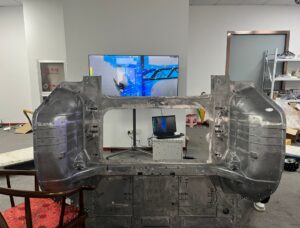How to design parts for metal 3D Printing?
With the gradual popularization of 3D printing, more and more users will directly consider metal printing when producing products, so how to design a product suitable for metal printing? Is anything we should pay attention to? IN3DTEC will analyze the design skills of metal printing for you through many cases.
Content
- Metal printing materials and their advantages
- Frequently asked questions on Metal 3D Printing
-What’s the minimum wall thickness of metal 3D prints?
-How to design the letters, grooves, and steps on metal 3D Print?
-What’s the required gap width of metal 3D Prints?
-Is 3D printed thread can be used directly?
-How to improve the smoothness of metal 3D Prints?
-What’s the difference between metal sandblasting & glass beading in 3d printing?
-How to avoid the support in metal 3D Printing?
-What is the tolerance of metal 3D Printing?
-Can IN3DTEC CNC machining my 3D Print?
-Is it possible to anodize the Alumimum 3D Print?
-Is it possible to solder the metal 3D Prints? And how it looks like?
-Can 3D printing print Copper, and gold?
-What’s the density of metal 3D printing?
-How about the airtightness and water tightness of metal printed parts?
-What should I know if my metal 3d prints need assembly?
-How to improve the bending strength?
- How to reduce the cost of metal 3D Printing?
Metal Printing materials and their advantages
- Titanium (Ti64, grade 5) : High strength and low density, good mechanical properties, good toughness and corrosion resistance, lightweight, and good biocompatibility.
- Aluminum(AlSi10Mg): High plasticity, high corrosion resistance, good electrical conductivity, and thermal conductivity, easy to withstand various pressure processing and extension, bending, and can be used for gas welding, argon arc welding, and spot welding.
- Stainless steel (316L): High strength, corrosion resistance, good heat resistance, and excellent polishing performance.
- 17-4PH : High Elongation, good wear resistance, excellent Yield strength, and Tensile strength.
- Maraging steel: High heat resistance, excellent tensile strength, and elongation.
- Copper: High electrical & thermal conductivity.
- Inocel 718: Excellent Heat resistance.
The above materials are available from IN3DTEC Metal 3D Printing Service.
Frequently asked questions on Metal 3D Printing
What’s the minimum wall thickness of metal 3D prints?
Edges or details have thin thickness: 0.6minimum is recommended
The whole part has a thin thickness: 1.2mm is recommended, or it has a deformation risk.
How to design the letters, grooves, and steps on metal 3D Print?
About letters/font:
Sunken font
Width: Needs 0.6mm minimum
Depth: Bigger than 0.6mm and less than 1.0mm
Protruding font
Width: Needs 0.6mm minimum
Height: Bigger than 0.6mm
Groove: 0.6mm minimum
What’s the required gap width of Metal 3D Prints?
The gap between walls: 0.6mm minimum is recommended
Is 3D printed thread can be used directly?
Metal 3D printed thread is not suitable for use directly, so tapping the thread is necessary
How to improve the smoothness of metal 3D Prints?
First, you need to ensure the resolution of the parts is very high. Some customers don’t know how to export a higher-resolution STL format. In this way, it is better to send STP file to IN3DTEC.
Secondly, the printing orientation will slightly affect the smoothness, so hiring a professional metal 3D Printing provider to make your parts is very important.
Lastly, polishing the surface will be a good choice, and it can be done by auto-rotating equipment with stone or magnet, which might damage some tiny details. Or by manual polishing using grinding tools.
What’s the difference between sandblasting & glass beading in Metal 3D Printing?
Sandblasting is like a lady applying makeup powder to her face. It makes the parts look beautiful.
Glass beading using glass beads to hit the object’s surface at a very high-speed result in a very satin/glossy surface finish.
Both methods can create a uniform surface
How to avoid the support in Metal 3D Printing?
It absolutely a headache when you find the parts have some residual support. So below skills can help you avoid this.
- Parts have internal channels, see the below image,
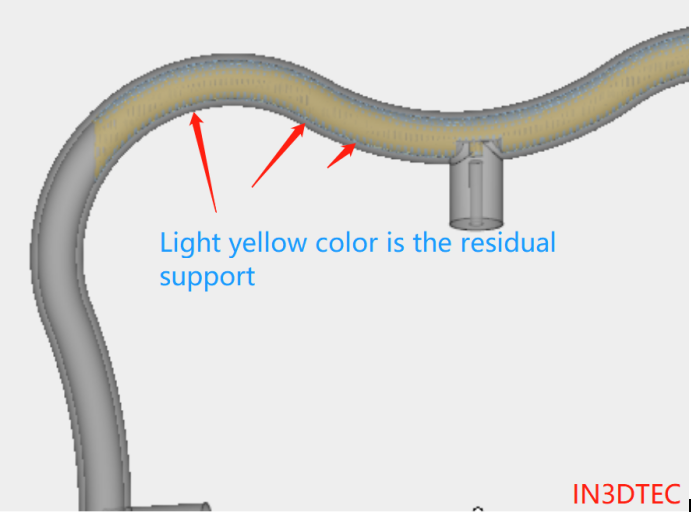
You might wonder why this part needs support? Just imagine, you are building a bridge, support is like pillars. The bridge will drop down without pillars. However, a small countryside bridge doesn’t need support at all, correct? So let’s make the internal channel smaller to build it without support.
2.Parts have slop/angle,
A simple rule to avoid this kind of support: 45° angle is very important in metal 3d printing. More extensive than 45 degrees will have no support, and less than will have.
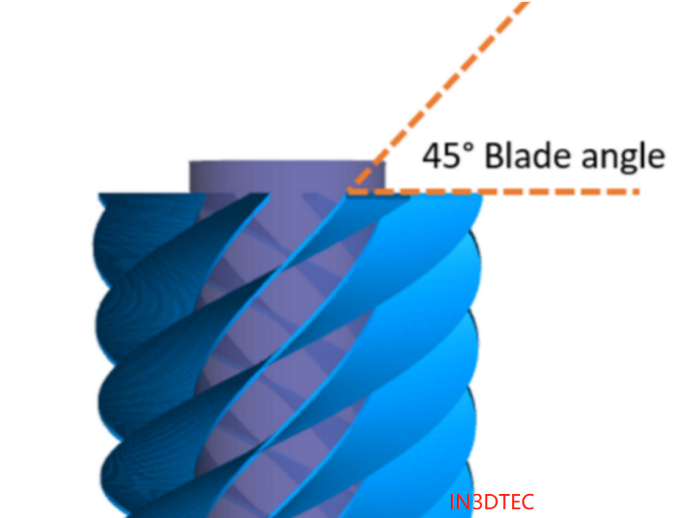
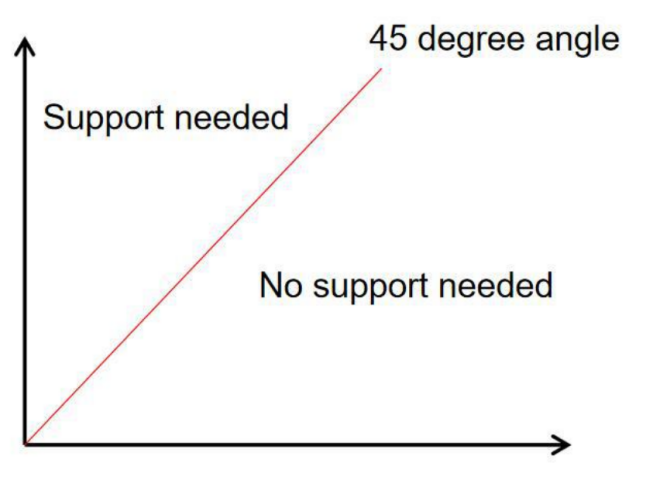
3. Split the parts, then solder,
This will be an excellent way to solve parts with an inner support issue for tube-like parts.

Lorem ipsum dolor sit amet, consectetur adipiscing elit. Ut elit tellus, luctus nec ullamcorper mattis, pulvinar dapibus leo.
Is support necessary for metal 3d printing?
We would like to say no. However, without support, printing has a high risk of damaging the prints. So most of the metal 3D Printing service providers like IN3DTEC prefer to add support when printing metals.
Suppose you are working on a research project and willing to bear high research and development costs(as most prints will fail without support). We are also glad to help.
What is the tolerance of metal 3D Printing?
0.03mm layer thickness, overall +/-0.2mm tolerance.
Can IN3DTEC CNC machine my 3D Print?
Yes.
Is it possible to anodize the Alumimum 3D Print?
Yes, it can be. However, the surface appearance will not be as good as machined ones.
Is it possible to solder/weld the metal 3D Prints? And how to make it?
Yes, please check the below image. The soldering must be a combination of laser welding and argon arc welding.
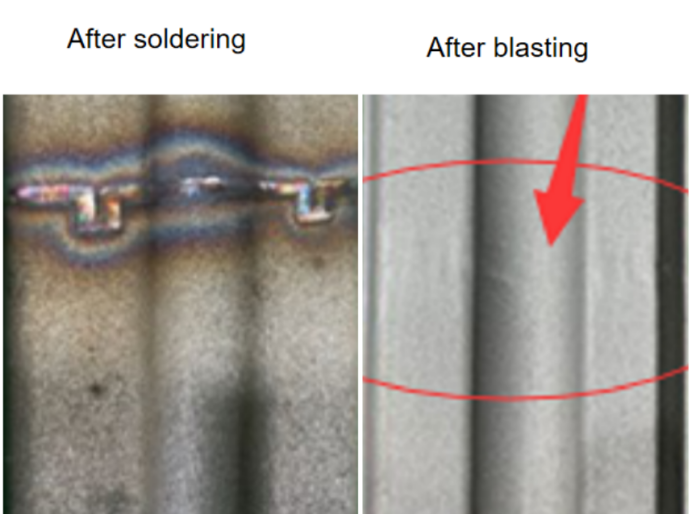
Can 3D printing print Copper and gold?
Copper is printable. However, gold is not available now, mainly because gold is too soft, the laser power will destroy the finished layers, and gas protection for gold is also an issue.
What’s the density of metal 3D printing?
99.99%
How about the airtightness and water tightness of metal printed parts?
IN3DTEC has tools to test and ensure its air and water tightness under different pressure.
What should I know if my metal 3d prints need assembly?
It is recommended that the assembly clearance on one side be 0.15mm
How to improve the bending strength of Metal 3D Printing?
Absolutely, you need heat treatment if you care more about this. There are two types of heat treatment processes.
Common heat treatment: Use an ordinary annealing furnace for internal stress relief. This is not much help to improve the bending strength. It is mainly for preventing the deformation of the parts during use.
Professional heat treatment: Also named vacuum annealing, this is an excellent way to improve the bending strength.
How to reduce the cost of Metal 3D Printing?
The benefit of metal 3D printing is that it can make very complex parts, which means you can reduce costs by reducing weight because the cost of metal printing depends on the weight of the material.
There are some topology optimization software that can help you Altair,OptiStruct ,nTopology,Autodesk Fusion 360 with Netfabb,Ansys Discovery,Siemens NX / Solid Edge,Creo, Dassault Systèmes Solidworks.
Of course, it is very important to select a metal 3d printing service provider like us who can help you check designs before making them.


